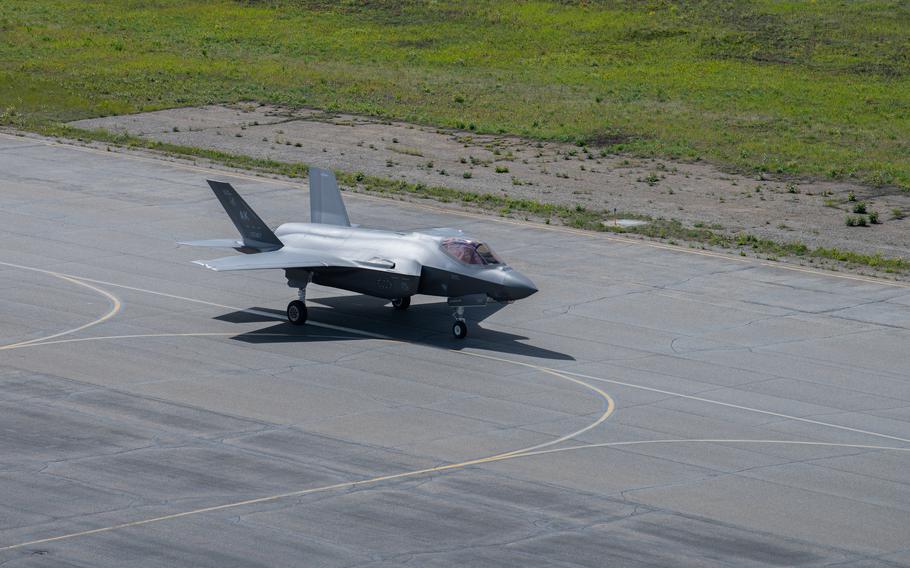
A U.S. Air Force F-35 Lightning II with the 356th Fighter Squadron taxis to the runway during Red Flag-Alaska 2023 at Eielson Air Force Base, Alaska, June 13, 2023. (Cedrique Oldaker/U.S. Air Force)
A U.S. House panel, seeking to advance competing priorities while adhering to spending caps under debt limit law, wants to prevent two amphibious assault ships from being retired and boost the Air Force’s F-35 Joint Strike Fighter fleet.
At the same time, the House Appropriations Defense Subcommittee would shift as much as $20 billion from what it sees as poorly justified funding requests — including parts of the Pentagon’s top priority to buy munitions in bulk.
“We have $20 billion of money we are rearranging and putting that into priorities to make this a better and stronger force,” subcommittee Chairman Ken Calvert, a California Republican, said in an interview. The defense cap in the debt limit bill is $886 billion, and the panel’s allocation for national security programs is $826 billion.
The defense spending proposal is the first salvo in what is likely to be a fight in Congress over national security spending and competing priorities for the GOP and Democrats. The U.S. is the linchpin for security assistance to Ukraine’s fight against Russia’s invasion, at the same time Washington prepares for competition and conflict with China in the Pacific region. The House version must be reconciled with the still-to-be disclosed Senate bill.
One of the panel’s biggest economies would authorize the Pentagon to enter into contracts of typically five years, for five of seven requested munitions programs, intended to signal a long-term commitment to industry — but with caveats.
The Pentagon is working to help industry ramp up and build sufficient munitions stockpiles for future conflicts. As Washington sent Ukraine Raytheon Technologies’ Stinger surface-to-air missiles and Javelin antitank missiles, made by Raytheon and Lockheed Martin, along with Howitzers and ammunition, it started to deplete its own stockpiles, demonstrating a lack of resilience.
While the defense panel allowed multiyear contracts for munitions, it denied the military the ability place bulk orders in the early years of the contracts for components — so-called Economic Order Quantities — on the promise of cost savings, which the panel assessed haven’t been adequately documented and won’t materialize. Forgoing the block buys would save $1.9 billion that can be shifted to other programs.
Instead, the panel’s draft spending proposal requires the military services to request annually the specific dollars used to buy components. Such requests are meant to strengthen congressional oversight. The five munitions that received committee backing are the Naval Strike Missile made by Raytheon and Kongsberg Defence Aerospace, Patriot Pac-3 missile Guided Multiple Launch Rocket System, Joint Air-to-Surface Standoff Missile, and Long-range anti-ship missiles - all made by Lockheed Martin.
House Democrats, meanwhile, have criticized the Republicans’ multiyear funding strategy as a failure to “counter Chinese Communist Party threats.”
Reduces civilian workforce
Calvert’s panel wants to save $1.1 billion by reducing the Defense Department’s civilian workforce through a combination of annual attrition of personnel — up to 10% a year — and using automation and artificial intelligence to modernize operations and require fewer people, a keen interest of the chairman.
“We need to reform, disrupt the department — almost throughout the private sector, you see people using their workforce more effectively and more efficiently,” Calvert said in the interview. “We are not talking about firing anybody. The civilian personnel levels are at the highest level, proportionally to the military, than they have ever been.”
The Defense Department has more 800,000 civilian employees costing $100 billion a year, he said, and the reduction proposed represents 1%. “It is a start. And over time, then we find efficiencies and we get better outcomes,” he added, citing changes in payroll and accounts payable.
Here are some of the other cuts the defense panel proposes shifting into other accounts to help stay within the defense cap:
•$402.4 million from Boeing’s MQ-25 Stingray refueling drone for aircraft carrier jets due to contractor management challenges that have slipped aircraft deliveries to fiscal 2024 and 2025 instead of this year;
•$150 million from the Air Force request for continued development of the Lockheed Martin ARRW hypersonic weapon, essentially ending the program that’s had a mixed test track record;
•$82.4 million in what the panel calls “unjustified growth” in the cost of shipbuilder studies for the new SSN(X) submarine;
•$45 million requested for the poorly performing Raytheon OCX series of ground stations for controlling U.S. GPS satellites;
•$28 million in what the committee calls “unjustified cost growth” in Boeing F15EX jet support costs which grew to $108 million from $80 million this year;
•$27 million requested by the Space Force for outfitting a “Consolidated Space Operations Facility” in Colorado that won’t be occupied until 2027;
Increases Air Force F-35 fleet
The spending proposal, meanwhile, would boost the Air Force’s fleet by three Lockheed F-35 Joint Strike Fighters, above the Pentagon’s request of 48 planes for the service. The panel doesn’t support including a new engine for the F-35 fleet, according to a provision contained in the legislation. The current engine is made by Pratt & Whitney.
While the defense committee wasn’t able to fund an additional amphibious assault ship because of budgetary limits, it plans to prevent the Navy from retiring two of the vessels.
Pentagon budget planners proposed suspending purchases of amphibious ships in the year starting Oct. 1, a controversial move that would lower the fleet numbers below the statutory requirement of 31 ships.
The primary function of Navy amphibious ships is to transport Marines and their weapons, equipment, and supplies to distant operating areas, and allow Marines to conduct operations ashore in those areas.